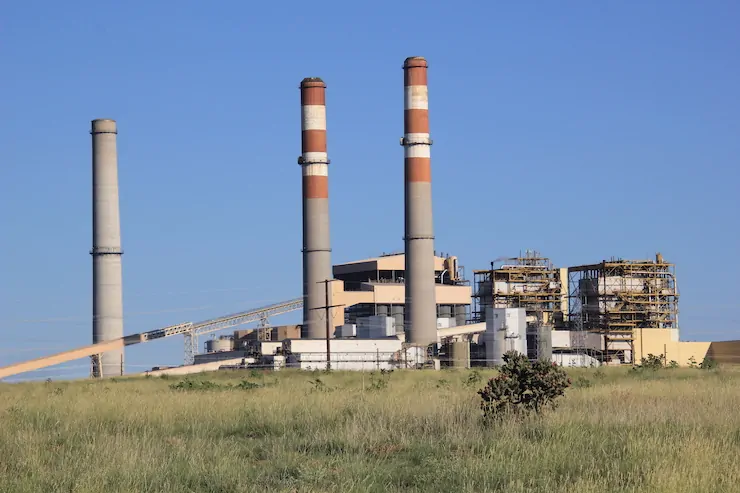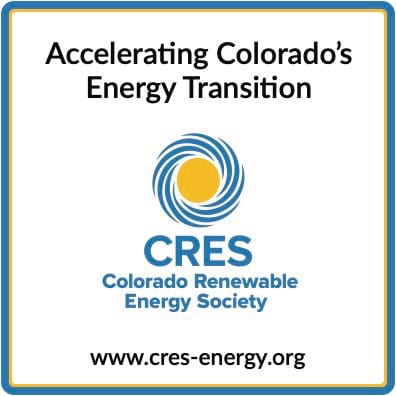PUC commissioners wrap-up 19 hours of “just transition” deliberations that became more about data centers than Pueblo’s future. A miffed Pueblo County says it has asked President Donald Trump to intercede.
The story in brief:
• PUC commissioners wrap up their deliberations that will give Xcel Energy far less than it asked but which will likely be the far largest outlay of new electrical generation in Colorado history.
• It started out several yeas ago as the “Pueblo Just Transition” solicitation but became dwarfed by the projected demand from new data centers. But will that demand actually arrive?
• Commissioners agree that the data centers and other large users should absorb some of the risk. It shouldn’t all be on the backs of residential ratepayers.
• Will Pueblo get a nuclear power plant or a gas-fired power plant when Comanche 3 closes in 2030? Frances Koncilja, a former PUC commissioner now representing Pueblo County, insists only this will leave Pueblo whole.
• Pueblo County is asking President Trump to intercede to keep coal units operating.
• Meanwhile, Xcel Energy, with support from the state, asks the PUC to allow a novel procedure that would allow the company to possibly get projects started before July 2026 in order to get federal tax credits.
by Allen Best
In Pueblo, with the three smokestacks of Comanche Generating Station in the distance, the Colorado State Fair on Monday wrapped up its 11-day annual schedule of carnival rides, rodeos, and rock ‘n’ roll. On Sunday night, the band Cheap Trick performed.
A few days prior, meeting virtually from their computers in Boulder, Edwards and Buena Visita, the three Colorado PUC commissioners ended their 10-month review of the latest electric resource plan by Xcel Energy. It’s a monster, if one tamed considerably from what the utility first proposed in October 2024.
Xcel had wanted to add 14,000 megawatts of new generation, with roughly 60% to 70% of that new electricity needed to serve data centers. It won’t get what it asked for. The commissioners were skeptical that the humongous growth in demand will arrive as the utility originally projected, but Xcel is still set to get 6,000 megawatts in new generation.
That, declared Eric Blank, the chair of the PUC commissioners, will “likely be the single largest resource acquisition in the history of Colorado.”
Adding this much new generation will cost $15 billion. This is investment to be made by Xcel’s 1.6 million customers in Colorado.
“To put this commitment into perspective,” Blank continued, “the total Xcel rate base in Colorado is currently roughly $12 billion by any measure. This is an enormous resource acquisition. This resource acquisition might include almost 4,000 megawatts of wind, 1,500 megawatts of solar, and 1,400 megawatts of peaking capacity (natural gas and batteries). This is all on a current system with a peak demand of roughly 7,000 megawatts.”

Construction of the QTS data center in Aurora in 2023 drew attention to what might lie ahead for Colorado, as has already occurred elsewhere in the world, most notably in an area of Virginia outside of Washington D.C. Top photo: Comanche Generating Station as seen on June 15, 2024. Photos/Allen Best
In 2022, when parameters of this case were framed, it was assigned the name “Pueblo Just Transition.” The major task then seemed to be figuring out what came next for Pueblo, in particular but also Hayden, after Xcel has closed all its coal plants in those two locations. Electricity demand had been growing, but slowly.
Xcel closed one of the three units at Comanche Generating Station in 2022 and will close a second unit this year. Combustion at the final unit, Comanche 3, is to end before the whistles celebrate the arrival of New Year’s Day 2031.
That was to be Colorado’s last coal-fired combustion, a milestone in the Centennial State’s journey to a decarbonized future.
That was then.
Now comes a report by the Pueblo County commissioners that they are trying to get President Donald Trump and his energy secretary, Chris Wright, the former CEO of Denver-based Liberty Energy, an oil and gas company, to keep the two remaining coal units operating at higher levels than planned and beyond scheduled retirements.
Only advanced nuclear
Pueblo, says the filing on Aug. 29, is getting a raw deal in the Xcel proceeding now being wrapped up by the PUC commissioners. It wants Trump to keep the coal plants burning until Pueblo truly gets a just transition.
The PUC, said Pueblo County, has not upheld its end of the agreement with Pueblo about what constitutes a just transition for coal communities.
Comanche provides very little electricity for Pueblo County. There, the dominant supply comes from Black Hills Energy. The coal units do provide $31 million annually in property taxes and relatively well-paying jobs.
Pueblo County, according to a filing with the PUC on Aug. 29, should get a nuclear power plant or at least a gas plant.
In 2023, Xcel Energy convened a task force along with Frances Koncilja, a former PUC commissioner who grew up in Pueblo. The task force issued a report in January 2024 that proclaimed advanced nuclear to be the answer.
“Only advanced nuclear will make Pueblo whole and put the community on a path to prosper,” it said. “A new combined cycle gas plant with carbon capture provides some jobs and taxes but does not come close to replacing Comanche 3.”
Sounds good, but advanced nuclear — an umbrella word for various nuclear technologies — remains mostly hypothetical. Nuclear power plants built in recent years have been beset by humongous cost overruns.
Carbon capture has received lots of federal money, too, but it also remains mostly hypothetical.
How about a gas plant sans carbon capture? That seems to be today’s talking point.
“The company and the grid desperately need new gas plants,” said Koncilja in her filing on behalf of Pueblo County. The county has “solar fatigue,” she declared, citing the testimony of Commissioner Zach Swearingen before the PUC. Solar projects have been contentious and the relatively few jobs the solar projects deliver are low paying.
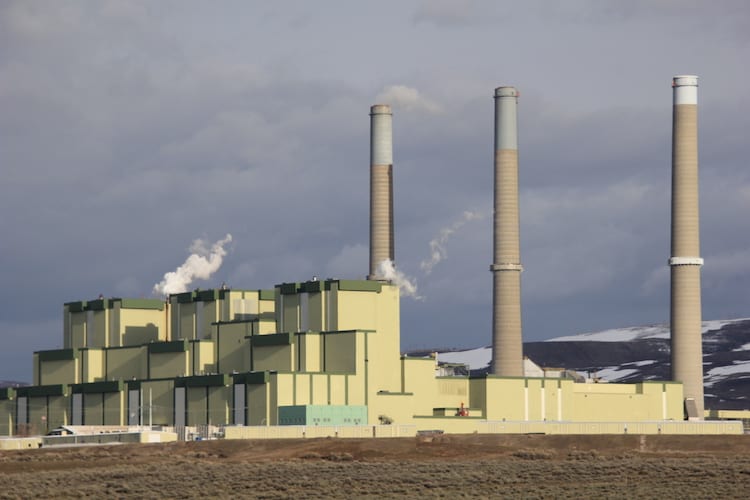
The Colorado PUC commissioners in August said that the evidence was clear that reliability of electricity deliveries by Tri-State Generation and Transmission would not be endangered by closing unit 1 of the Craig Generating Station. Photo/Allen Best
Might Trump intercede in Colorado energy matters, ordering that the coal keeps burning in Pueblo until Xcel commissions a nuclear or gas plant?
Trump’s actions in his second term have ceased to surprise. His executive order under authority of section 202(c) of the Federal Power Act that coal plants remain operating has succeeded in limited cases.
Canary Media reported that the Trump administration last week extended two emergency orders that fossil fuel plants in Pennsylvania and Michigan continue operations. Both had been scheduled to close in May. A Grid Strategies study promoted by several national environmental groups concluded that the forced continued burning of coal could cost consumers $3 – $6 billion.
Pueblo County’s saber rattling was couched in terms of grid reliability. How important are coal plants? The PUC has made no finding in the context of Pueblo. However, the PUC commissioners addressed this issue of grid reliability very directly in a decision issued on Aug. 26 if narrowly in regard to plans by Tri-State Generation and Transmission regarding one unit at Craig Generating Station.
“Craig Unit 1 is not required for reliability or resource adequacy purposes based on the record in this ERP (electric resource plan). Every portfolio that Tri-State modeled assumes that Craig Unit 1 retires at the end of 2025 and does not provide any energy or capacity after 2025. At the same time, Tri-State convincingly concludes that every portfolio meets all reliability metrics and is reliable.”
“Perhaps this (PUC) Commission is biased against Pueblo because it voted for President Trump twice,” Koncilja wrote. “Perhaps this Commission has decided that it will not consider the construction of new gas plants in Pueblo or any other community. Perhaps this Commission has decided that it will not even consider innovative technologies such as advanced nuclear, for coal communities. Perhaps the Commission had decided that only the voices of the environmental organizations will be considered.”
What exactly is just transition?
Koncilja’s rhetoric is raw, over the top. But with the acid removed, she asks a legitimate question: What constitutes just transition for Pueblo?
In 2019, when specifying 80% greenhouse gas emissions reductions by 2030 from the power sector, Colorado legislators also clearly said that communities dependent economically on coal extraction and combustion should not be left alone to figure out their futures. In HB19-1314, they ordered a “Just Transition from Coal-based Electrical Energy Economy.”
In Hayden on Aug. 20, Wade Buchanan, who runs the state’s just transition office, spoke at a conference devoted to geothermal. The conference was held at the Yampa Valley Regional Airport, which lies a mile or two west of the Hayden Generating Station. Across the road from the airport lies a new business park. Heating for the businesses is to be provided by ground-source heat pumps. They can provide cooling, too, and it would have been useful that day. Temperatures topped 90 degrees even as smoke from fires near Meeker smothered the Yampa Valley, for a time obscuring Bears Ears, the mountain north of Hayden.
Wells were being drilled and trenches dug for the geothermal-heated business park. Amazon was said to be one of the future tenants. Hayden is gearing up for a post-coal future.
Buchanan wondered if any of the 120 attendees had been given a name by their parents they just didn’t like? That was the case with the just transition office, he said. “It doesn’t communicate. Folks don’t know what it means. It comes across as confusing or pejorative.”
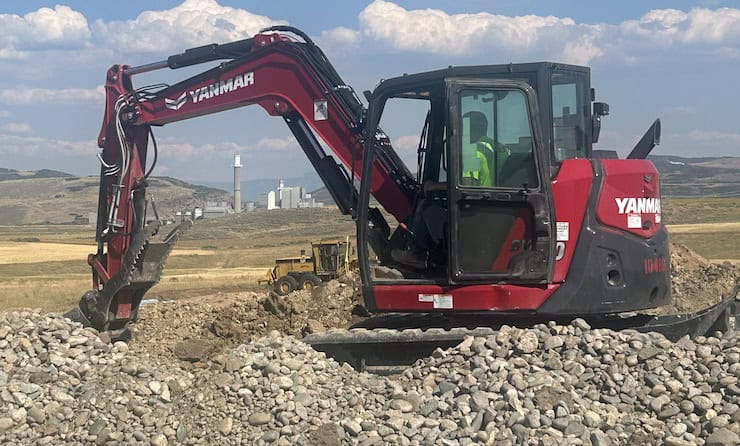
With the soon-to-be-closed Hayden Generating Station in the distance, work is underway in Hayden to create a business park whose buildings will be heated (and cooled, if necessary) by ground-source heat pumps, i.e. geothermal. Photo/Allen Best
In her PUC filing, Koncilja described the $165 million that Xcel has promised to pay in property taxes in the decade after Comanche 3 closes in 2030 as a “pittance.” As for the report she helped assemble two years ago, she complained that the PUC commissioners and staff members had discussed community benefits for less than 15 minutes during their 17-plus hours of deliberations. As for the report she helped prepare that called for nuclear, there was just one passing mention.
Koncilja appeared to also be the lead author on a July 17 filing that reviewed the long-term jobs, salaries and property taxes of the various energy possibilities for Pueblo. A combined-cycle gas plant with carbon capture came out second best with 20 to 25 jobs paying $80,000to $120,000 annually and delivering $16.5 million in property taxes. Nuclear, of course, had more of everything: 200 to 300 long-term jobs and property tax payments of $95 million annually.
That same filing jabbed at environmental groups. “Their real goals seem to be to stop any new gas generation, and the workers of Comanche and the Pueblo community are collateral damage,” said the filing by Pueblo, the city, and Pueblo County.
Leslie Glustrom, a constant presence at the PUC as well as the inaugural rollout of the nuclear report in Pueblo in February 2024, accused Koncilja of the political equivalent of trying to get a billion-dollar gift in the form of a nuclear power plant, she said in an interview.
“Given that we have much lower-cost options and options that all complement the flexible nature of 21st century resources, it should have been obvious to former Commissioner Koncilja that she was holding out false hope for the Pueblo community.”
Might nuclear someday become cost competitive (and with solutions for wastes)? Maybe. Xcel professes to think it will become viable in around 2035. So does Tri-State Generation and Transmission’s Duane Highley. And Mark Gabriel of United Power believes it will be an answer — if the federal government fully becomes engaged.
(For the record, the nuclear industry has received great amounts of subsidies over the years, and the Inflation Reduction Act of the Biden era added more. Chuck Kutscher, who trained as a nuclear engineer before moving into renewables, sees little future for nuclear, as he explained to an audience in April).
Colorado utilities going with natural gas
In the near term, though, Colorado utilities have been placing bets on renewables shored up with natural gas. Notably, La Plata Electric in Durango, now led by Chris Hansen, one of the architects of Colorado’s energy transition, left open the door for natural gas in its recent solicitation.
Brighton-based United Power was first out of the chute. Independent of wholesale power provider Tri-State since May 2024, it managed to get a 162-megawatt power plant called Mountain Peak Power constructed in just 20 months. That just might be a record.
“I have been in this business for more than three decades, and I can tell you, I have never seen a project get done so quickly,” said Gabriel, the chief executive, at a ribbon-snipping ceremony on Aug. 28.
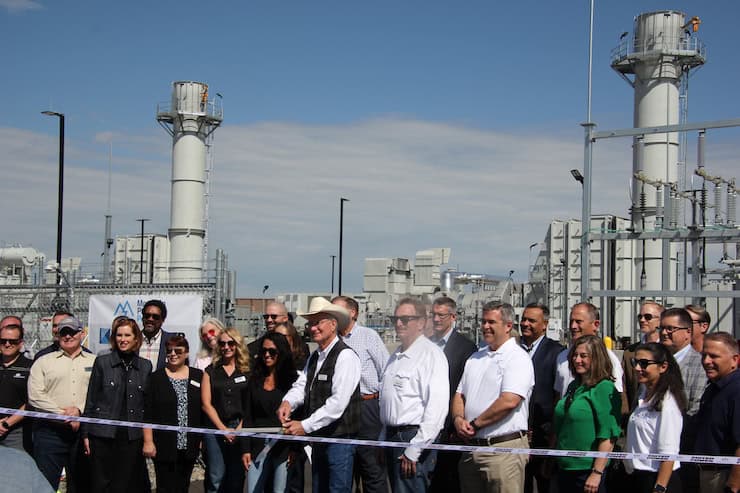
Directors of United Power 20 months ago pulled the trigger on what CEO Mark Gabriel described on a $250 million risk. By July, it was producing power even as demand soared on the hot days. Photo/Allen Best
Power production from Mountain Peak Power began in July, just in time to meet new peak demands for power from members of United, an electrical cooperative unregulated by the PUC. The cooperative last year invested in 11 megawatts of new battery storage, and they paid for themselves almost instantly in meeting peak summer demand, said Gabriel.
Mountain Peak Power, which Gabriel described as a $250 million bet, he believes will prove equally good as an investment.
No words of sorrow about the loss of coal were spoken in the remarks preceding the ribbon-snipping on Aug. 28, although several times “clean burning natural gas” was mentioned. U.S. Rep. Lauren Boebert, in whose district the new gas plant is located, gave a three-minute talk that complained of “regulations from the top that really regulates us into poverty.”
Getting the horse before the cart
Colorado’s problem, however, has not been of poverty, but affluence — and supply chains.
United Power has been rapidly growing. Its service territory extends from the foothills to the oil and gas operations of the Wattenberg Field, but most importantly the fast-growing commercial sector of the Interstate 76 corridor northeast of Denver.
Might more growth come from data centers? Gabriel acknowledges getting inquiries, but his board of directors months ago adopted a policy that essentially says larger users need to put skin in the game. They want lots more power? They need to put money up front.
That’s essentially what the PUC last Thursday decided. It wasn’t a snap decision. That had been the fundamental question in front of the commissioners since last October. How much of this vast increase in demand would be real?
“There is a real risk that if these new, uncommitted loads don’t materialize, it will likely substantially raise existing customer rates,” said Blank in his opening statement on the final day of deliberations. ” Xcel, he added, has been unwilling to share any “material amount” of this risk. “We need to be cautious about acquiring new generation resources before the new load is contractually committed.”
Environmental groups had suggested that rates could conceivably rise by 50% by 2031 if the demand does not arrive to pay for the new generation.
Blank’s colleagues were on the same page. It was, said Commissioner Tom Plant, a matter of getting the cart before the horse. Commitments needed to arrive before investment in new generation. He estimates that somewhere between 50% and 90% of the inquiries will be “more style than substance,” he predicted. “‘Eighty percent still haven’t signed anything.”
Megan Gilman, the third commissioner, said it is inappropriate to put all the risk on Xcel’s ratepayers if Xcel itself is not willing to shoulder risk.
“I think we have crafted a fair outcome here to ensure that we protect other ratepayers but are ready, willing and able to respond quickly to real loads that are coming.”
The solution adopted by the PUC — to be detailed in a written order that might well run 100 pages or more — lays out the specifics in thresholds of 20 megawatts and 50 megawatts for demands from data centers and other prospective large load customers. This is to be done through agreements called electric service agreements, or ESAs. At the PUC, they do love their acronyms.
Less time during the PUC commissioners’ final deliberations was devoted to the accuracy of Xcel’s growth in demand for electricity from building electrification and electric vehicles. If Xcel builds in expectation of demand from these sectors that fails to arrive as projected, that will result in higher rates. Those higher electric rates could then have the effect of discouraging people to invest in these new technologies. Plant thought that Xcel needs to get more incentive in devising rate structures to encourage EV charging when electricity is plentiful.
Rushing to meet the federal deadline
Even as the commissioners talked about the need to be nimble, lawyers — including Koncilja — were assembling filings in response to a proposal by Xcel for something called a near-term procurement. This is the filing that provoked Koncilja’s rant about Pueblo.
Xcel, along with the PUC staff, the Colorado Energy Office and the Office of the Utility Consumer Advocate, asked the PUC commissioners to initiate a near-term procurement — henceforth reduced to the acronym NTP.
The basic thrust is that H.R. 1, otherwise called the One Big Beautiful Bill and passed by Congress in July, should hurry the process of Xcel getting bids. “Time is of the essence,” says the filing. Developers and the company need rapid project approvals to get projects under construction by July 2026.
This NTP would create a platform to evaluate projects — including some anticipated by the PUC commissioners in the just transition case — of up to 400 megawatts of renewable and hybrid projects, 200 megawatts of thermal generation, i.e. gas, plus 300 megawatts of gas or energy storage.
Industry groups such as the Colorado Solar and Storage Association, in their filings on Aug. 29, echoed the language of the Xcel filing from the week before, which in turn had echoes of a letter on Aug. 1 released by Gov. Jared Polis. It spoke to the “critical, time-limited window for renewable energy projects to qualify for federal tax credits.” This proposed process that would get projects out to bid by February 2026 will send a “clear message to the investment and development communities that Colorado is open for business.”

Towns and cities in northern Colorado are nearly all thriving. Does Pueblo need a nuclear power plant to keep it “whole”? Photo/Allen Best
Environmental groups tersely noted that Xcel will most certainly need new resources and that the majority of that added electricity will come from wind and solar. Any projects that do not begin construction by July 4, 2026, and placed into service by the end of 2026 will become more expensive without federal tax credits.Holy Cross Energy, which still depends greatly on the electricity sold to it by Xcel Energy, applauded the “quick actions to pivot in the face of challenging Federal policy changes related to tax incentives for renewables energy resources. The electrical cooperative has minority ownership of Comanche 3, and these resources would replace that generation.” CORE Electric Cooperative was more reserved in its endorsement.
As for Pueblo, the city, it said that it intended to continue working to “create a high-tech clean energy hub,” and reminded the PUC commissioners to review the previous record regarding the just transition for the community.
The question now becomes whether anybody will want to build a gas plant in Pueblo or otherwise create a new tax base and jobs for the community and in what form. Xcel has land there and existing transmission lines.
Furthermore, the PUC is adopting a formula that seeks to give extra weight to a generating source proposed in the Pueblo and Hayden areas. One example — from a source in the solar industry — is that if Xcel got a bid for $39 for a project in Yuma County, and one for $41 in Pueblo County, and a $3 just transition “adder” was created for projects in just transition communities — the Pueblo County project would win.
One idea — discarded as impractical by Koncilja as an idea from “out of town environmental ‘experts’ — is of an energy park using various new technologies. It remains a vague idea. But then, as one of the PUC commissioners noted, it’s hard to know now exactly what technologies will be relevant in 2050. Consider that Comanche 3, when approved in 2004, was supposed to keep burning coal until 2070.
Exactly how this might look won’t become clear for several months. Knowing what projects might end up in Pueblo as a result of that added weighting, that’s likely a story for next year and conceivably beyond.
This story was amended to make clear the statements of Leslie Glustrom, as a statement had been erroneously attributed to her.
- Another (near) Lake Wobegone year - November 15, 2025
- Bryan Hannegan & the bigger leagues - November 15, 2025
- After a misstep about nuclear, DIA now looking at all energy options - November 13, 2025

